As long as I can remember, I have had a fascination with textiles. One of my earliest memories was that of rubbing my fingers over the linen texture of the note paper we children used to write our “Thank You” notes. I was fascinated by the texture. Then, in 1979, I saw an ad for a used Ashford spinning wheel and thought,”Hey wouldn’t it be fun to learn to spin!”
We were in the midst of the back-to-the-land movement and learning to spin was one of the resurrected crafts. People were making thick, funky yarns for bulky sweaters and, soon, so was I. I learned to crochet and knit. I was so pleased with my yarns – they had that wonderful thick and thin quality. My first sweater was a wonder – those thick and thin yarns were not sophisticated commercial “novelty yarns”, but I didn’t let that stand in the way. If the yarn seemed too thin and the knitting looked weak, I just added a second strand of yarn until the knitting looked thick enough and then I would just drop the second strand.
Of course, since we lived on an acre just a short distance from the city limits, we could go the whole route and have a couple of sheep. Through a friend I was introduced to a farmer who raised sheep, a rare breed called Romeldale – combining the best qualities of the lustrous Romney and the soft Ramboulet. I purchased two ewes whose fleeces were so easy to prepare and to spin – soon I had built up quite a stash of yarns.
I went on to explore natural dyes – our small walnut orchard provided a range of browns from light tan, through reddish to deep coffee bean color. There were mistletoe and lichens from the oaks in the nearby hills. I planted a madder patch and experimented with the many recipes available in the current spinning literature.
My spinning skills had now progressed to where my childhood wonderment with “texture” and “real cloth” came back to me. I was ready for what I thought was the ultimate challenge. I had been given my Mother’s loom. Now I asked her to pass her knowledge on to me.
Creating a Handspun, Handwoven Garment
After I learned to spin and knit, I wanted to move on to weaving with my newly made yarns. It never occurred to me that this was especially difficult. I had enjoyed the handwoven shawls that my mother had brought back from Mexico. The yarns used looked very similar to what I could make, so I just assumed that one threads the loom and begins to weave. As those shawls were made from singles yarn, I also just assumed that singles was the type of yarn to use. The first several projects were shawls made from singles and they turned out just fine. I’ve never turned back- I prefer singles as it produces fabric with a superior drape for garments.
I am often asked if it takes any special preparation to make warp yarns. My answer is I just spin up my whole fiber supply and divide by two. One half is the warp yarn and the other half is the weft yarn -all spun with the same easy long draw technique. If you can spin yarn that, when plied, is suitable for knitting, the singles will be suitable for weaving. Breakage is something that happens in weaving. Every weaving book will have a section on how to repair broken warps – the books are usually referring to commercial yarn. The main difficulty with singles is it has a tendency to tangle. This is true whether using a commercial or a handspun yarn. You can tame the tangling by using sizing. So go ahead and spin up your favorite fiber with a special handwoven garment in mind.
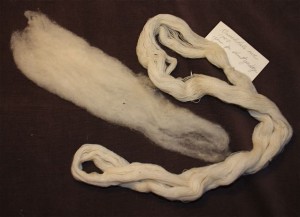
A Romeldale fleece spun for weaving yardage
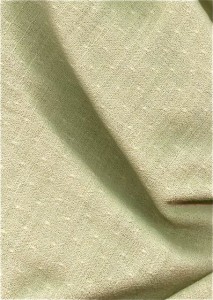
Handspun Romeldale wool fabric
I like weaving patterns that are mainly plain weave. With more complex patterns, the eye focuses on the weaving structure rather than the texture of the handspun. If I want to add some weaving interest, I choose a type of huck spots that has large areas of plain weave.
Garment Design
Because you are in control of the design of the cloth, you can place design elements in a creative way. You can put colored stripes just where you want them. You can add textural interest with judiciously placed novelty yarns while you weave. These elements can be placed so they come at exact places on the finished garment.
I prefer weaving patterns that are mainly plain weave as the focus is on the texture of the handspun. If you intend to use a novelty yarn for textural interest, just place one or at most three shots of the novelty. Otherwise, the unique character of that yarn will blend together and not really show up. Lay in about an inch of your foundation yarn between these texture rows. Of course, nothing beats making a sample so you can see how different treatments work.
Remember how the fiber talked to you and told you how it wanted to be spun? The cloth can do the same thing. It may tell you it wants to be made into something special. There are many choices for suitable patterns- commercial patterns, folk wear type patterns, or books with suggestions specifically for handwovens. Plan a special handspun, handwoven garment.
Cutting your Precious Fabric
If the thought of cutting makes you nervous – remember that you have made sound yarn, you have made samples and know that you have designed a good textile, and you have handwoven yardage that is good. – So, send the children to the neighbors for the morning, take the phone off the hook ( or put your cell on ‘airplane’ setting) and arrange not to be disturbed for the morning. Then tell yourself you are ready to accept this challenge.
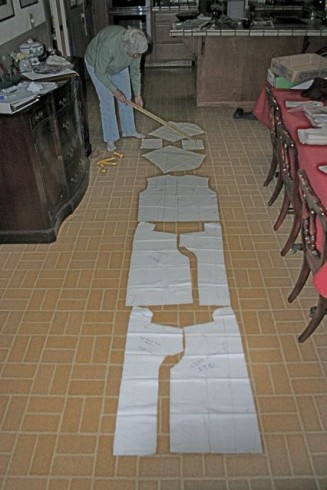
Checking how much yardage you will need
I have cut out all the pattern pieces and made duplicates if needed (ie. left front, right front) so I can lay them out to determine how wide and long my warp will have to be. If you don’t have a floor with lines, lay the pattern out on a long sheet of wrapping paper.
Even if you are going to make a straightforward bog jacket or a Japanese style tunic, to cut out the pattern pieces and lay them out ahead of time will allow you to get the best use of your yardage. Commercial pattern layouts are for (usually) much wider commercial fabric, so it is essential to work out a pattern layout ahead of time to know how much handwoven fabric you will need.
You will be using the standard steps of dressmaking or tailoring, so there is no need to panic; you have made good cloth. Proceed as you would with a good quality commercial fabric. If you are not an experienced sewer, get a good book on dressmaking or, better yet, take a class. Many community colleges offer classes on dressmaking at a reasonable fee.
Work carefully, taking one step at a time. When you have finished your garment, you’ll feel so proud to have made a wearable “from scratch.”
As you are working along on your project, keep notes. Put dates with these notes. Take pictures as you go along. After you finish, sit down and prepare a summary of your work.
List the fiber used and any interesting things about the fiber when you acquired it. Briefly describe the spinning experience. Summarize the weaving details, the sett and the length and width of you warp. Write up any interesting things that happened along the way. If you ran into problems, tell how you dealt with them.
Show Off your Finished Garment
Now that you have a finished garment, of course take some pictures. Put on your new garb and wear it in public. Enter the garment in local shows. The public enjoys knowing that it is possible to recreate the processes of history. Enter a fashion show. You may get stage fright, but realize that at most of the weaving guild shows, the models are weavers themselves, so you are in good company. If you can’t bring yourself to walk down the catwalk, find someone close to your size to model it for you. There is great joy in basking in the reaction of the viewers who learn your entry has been made “from scratch.”
The Long Journey
My fiber journey has been a long and interesting trip. I’ve made lasting friendships and I’ve had great mentors whose inspiration and encouragement carried me along. I was often frustrated by not being able to find instructions specifically for handspun yarns and I had no idea how to compare my yarns with what was suggested in the patterns. I discovered there were many misconceptions about weaving and sewing with handcrafted fabric so I decided to put the concepts I discovered along the way into a small book. It covers in greater detail how to create garments”from scratch.” The book is called From Fiber to Fashion- Spinning, Weaving, Sewing and can be ordered from me: pkarsten(at)pkarsten.com.
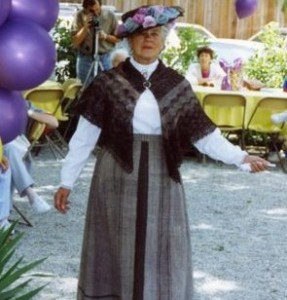
Phyllis modelling her creations at Custom Handweavers Fashion Show in Menlo Park
The skirt and wedding ring shawl were made with handspun wool from a Dorset ewe that Phyllis raised. The hat was felted from the same wool.
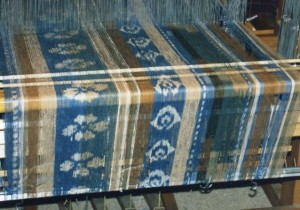
Another beautiful warp-becomes a beautiful garment
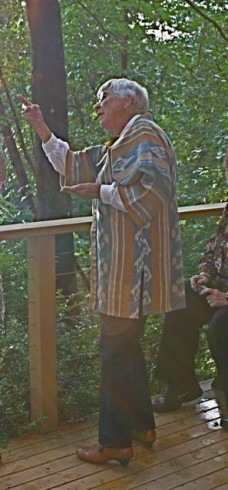
another beautiful handspun and hand woven garment made from natual colored cotton and overdyed in ikat technique with indigo
To read about another weaver’s approach to cutting and sewing handwoven fabric, click on Marlene.